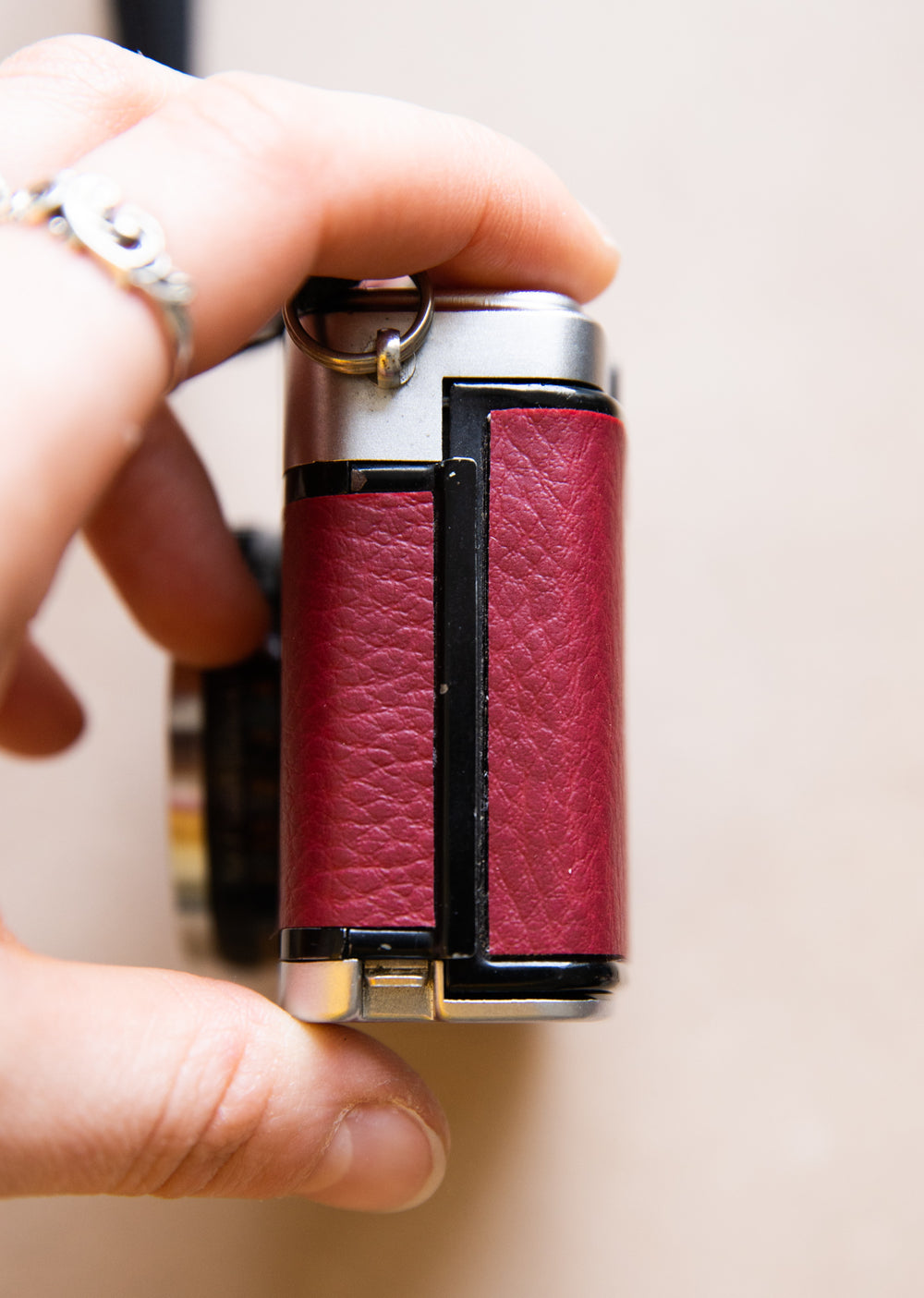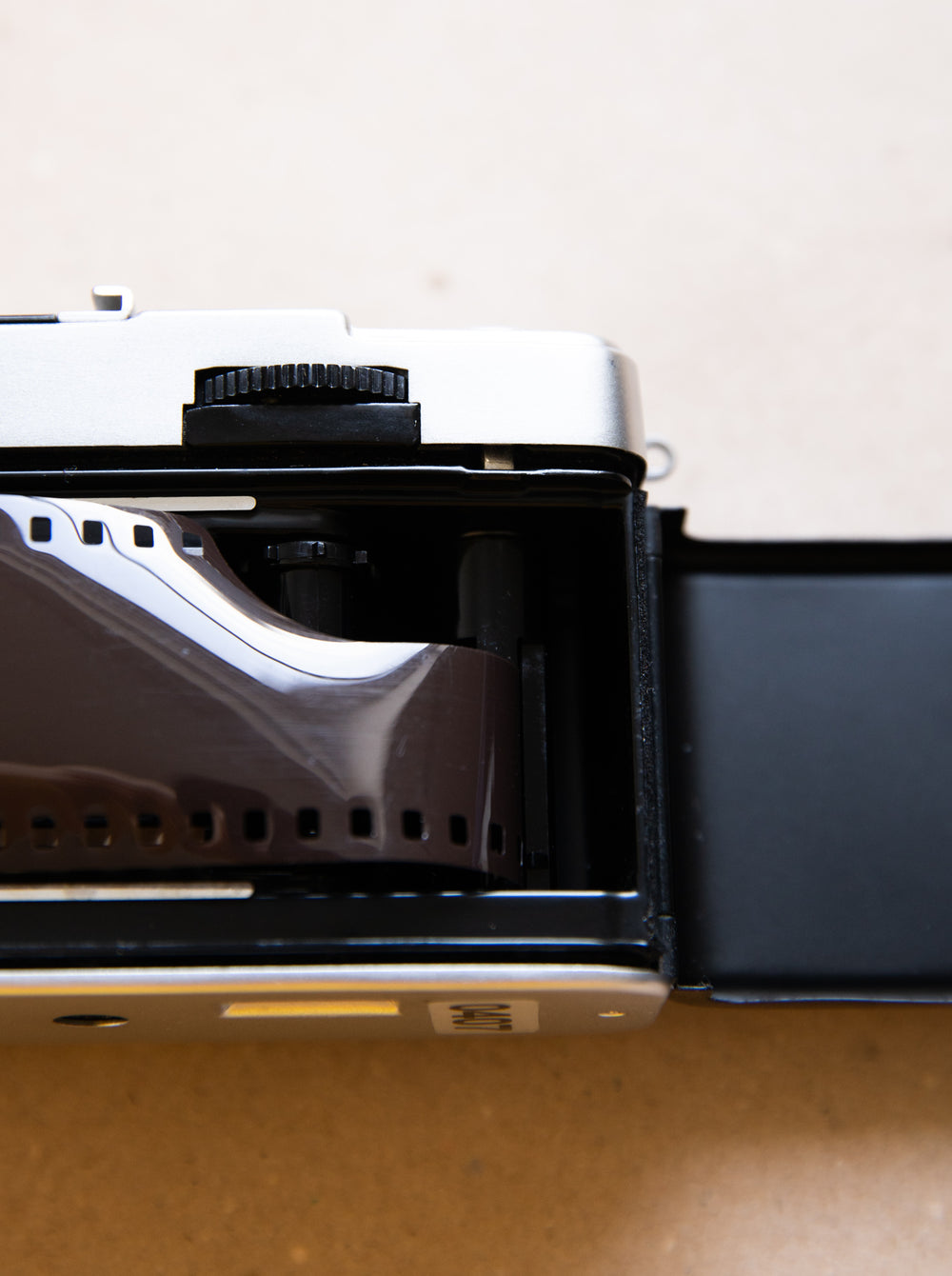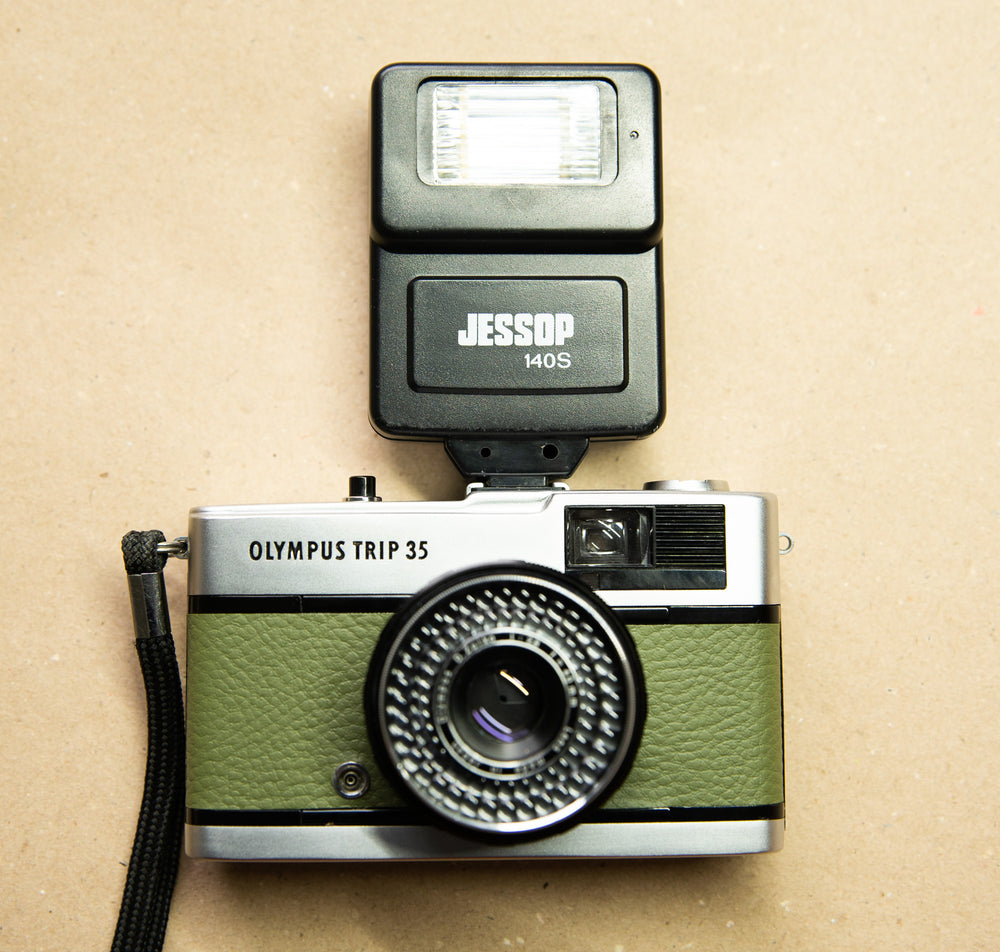The Olympus Pen EE-3 is one of our favourite half-frame cameras. It is compact, easy to use, and ideal for beginners. Here is our full guide on how to use this awesome little camera, and how to get the most out of it.

We have a full user guide available for the Olympus Pen EE-3. It covers everything you could possibly need to know about using the camera.
Jump to:
What is the Olympus Pen EE-3?
The Olympus Pen EE-3 is a compact, half-frame 35mm film camera. It was introduced in 1973, and was manufactured until 1982.
The Olympus Pen EE range has several different cameras to choose from. The Olympus Pen EE-3 is one of the over-looked and under-appreciated models.
Also, a fun fact: "EE" stands for "Electric Eyes".
What features does the Olympus Pen EE-3 have?
The Olympus Pen EE-3 has fixed focus, a wide 28mm f/3.5 lens, red flag feature, and automatic shutter and aperture settings.
The camera's light meter is powered by the selenium cell around the lens. This piece of the camera receives light and moves a small needle inside the camera to determine your shutter speed and aperture.
What filter size is the Olympus Pen EE-3?
The Olympus Pen EE-3 has a 43.5mm filter size. 43.5mm filters can screw onto the front of the lens. The best lens caps for the camera fit over the lens of the camera.
This is the same filter size as the Olympus Trip and the Olympus Pen EE-2 and EES-2.
Note: 43mm filters will not fit the camera.
What are the different parts of the Olympus Pen EE-3?
The Top Plate
The Olympus Pen EE-3 top plate is very simple. The camera features are easy to find, making it an ideal camera for beginners. Below is a labelled diagram of the camera.

On the left of the top plate is the rewind knob (more on that later). In the middle is the flash hotshoe, used for mounting hotshoe flashes to the camera. The shutter button is the small black button on the top. The small panel on the right is the shot counter that displays the number of shots you have taken.
The Lens
This is the only part of the camera where you can make adjustments for the settings. Turning the black ring of the lens selects the ASA of your roll of film, and also has the aperture settings for the flash controls.


The ASA dial is set to match the roll of film that you put in the camera. For example, if you are using Portra 400, the ASA setting is set to 400.
There are no focus settings on the Olympus Pen EE-3, which makes taking photographs so much quicker and easier.
The orange aperture settings are only used if you are using flash. Otherwise, the camera is set to one of the ASA, which allows the camera to choose the aperture and shutter speed automatically.
The Bottom Plate
There is only one function on the bottom plate of the Olympus Pen EE-3: the rewind button. (And the tripod mount, technically.)

The rewind button is pressed when you are ready to start rewinding your film.
How To Load Film In The Olympus Pen EE-3
Loading film takes some practice, but it is really easy when you get to grips with it.
To load a roll of film in the Olympus Pen EE-3, first you have to open the back of the camera. To open the back of the camera, pull down this small silver tab, shown below.


Once you have the back of the camera open, you can load your roll of film. To load the roll of film, pull the rewind knob up. The roll of film goes in with the top of the canister (the part that sticks out) at the bottom of the camera. See the image below.


When the canister is in, you can pull the film leader across the camera to reach the other side.

The rewind knob being put back down will lock the canister in place as you pull the film across. In order to lock the film onto the film spool in the camera, it has to go partly into one of the slots, and the notches at the bottom of the spool have to go through the sprockets on the film (the holes).

In order to be able to advance the film across the camera, you have to fire the shutter. You can do this by pointing it at a bright light or by setting the aperture setting to one of the orange numbers.
I recommend firing the shutter, and advancing the film (with the advance thumb wheel) twice before closing the back, so that you can make sure the film is definitely loaded correctly. As you get more confident, you can fire the shutter less times and therefore get more photos on your roll of film.
How To Take Photos With The Olympus Pen EE-3
Now you have loaded your roll of film, and closed the back of the camera, you are ready to start taking photos!
The first thing to check is that your ASA is set to the same speed as your roll of film. For example, Portra 400 is ASA 400. Or Kodak Gold is ASA 200.

When looking through the viewfinder, you will be able to see your frame lines.

When the lens is set to one of the ASA settings, the camera will choose the shutter speed and aperture for you manually. If the image you are trying to take is too dark, the red flag will come up.
You can override this by setting it to one of the numbers instead, but be aware that these are intended for a flash to be used with it. By setting the Olympus Pen EE-3 to a number on the lens, it reduces the shutter speed to 1/30 - that's one thirtieth of a second. So you will need to have a steady hand when doing so.
How does the film counter on the Olympus Pen EE-3 work?
When you first load your roll of film, it may look as though the film counter is not moving. It takes two or three shots for the shot counter to move to the number one.
The back of the camera needs to be closed in order for the shot counter to start working.
The counter shows the amount of images you have taken, not how many you have left.


How does the Olympus Pen EE-3 red flag feature work?
The purpose of this Olympus Pen EE-3 feature is to stop you from taking a photograph that is not exposed enough and therefore will not be visible when developed.
When there is not enough light in your image, the red flag will pop up in the viewfinder. You will clearly be able to see it if you are looking through the viewfinder. It also blocks the shutter button from being pressed.

Can I use the Olympus Pen EE-3 at night?
Yes, you can.
The easiest way to do this is to attach a flash to the top of the camera.
Attaching a flash to the top of the camera is easy and most flashes can be used on the Olympus Pen EE-3. It has a standard flash hotshoe on the top of the camera.
Here is an example of a flash that can be used on the Olympus Pen EE-3:
When using a flash on the Olympus Pen EE-3, there are different settings to use. These are the orange aperture numbers on the lens.
The aperture you use needs to be read off of the meter table, which is usually displayed on the back of the flash unit.
Below is an example shown on the Olympus Trip.


How To Rewind Your Film
Congratulations, you've finished your roll of film.
How can I tell if the roll of film is finished?
You will start to feel some resistance when trying to advance the camera. Do not force it, as you will snap part of the mechanism.
If you are using a 24 exposure roll of film, you will have reached the 48th shot. The shot counter should show the number 48, or near to that number. The same applies for a 36 exposure roll of film, as this will show the number 72. Sometimes you are lucky and get 73 or 74 shots out of a roll of film.
When the film will not advance any more, the film is finished.
How do I take the roll of film out?
On the bottom of the camera is your rewind button. Push this button in. It should stay in after you have pressed it once.
You can now use the rewind knob to rewind the film into the canister. Turn the knob clockwise.

Rewinding the film usually takes around thirty seconds of rewinding. You will feel when the film comes off of the spool at the end, because the rewind knob will have less resistance. Keep rewinding it until you feel certain that the film is back inside the canister.
You can now open the back and take the film out.

That's just about everything you need to know about the Olympus Pen EE-3 35mm film camera! We really recommend this camera for beginners, so we hope you have a great time using it and create some lovely images.
I think my Olympus Pen EE-3 is broken; what should I do?
A lot of Olympus Pen 35mm film cameras have never been serviced. Common issues include: loose screws, missing screws, stuck aperture blades, degraded light seals, and other similar issues.
We highly recommend getting your Olympus Pen EE-3 serviced if it hasn't been used in a while.
All of our Olympus Pen EE-3 services and repairs are very affordable, so definitely consider sending it to us before deciding that it doesn't work, or putting it back in a drawer.
Find out more about the Olympus Pen cameras here:
Shop our full range of Olympus Pens and accessories here:
If you like what we do, but can't buy a camera from us, please consider buying us a cup of coffee! It helps us to keep these resources free, consistent, and accessible.
Still stuck on which film camera to buy?
Try our film camera quiz. All you have to do is answer a few questions, and then you will get a list of personalised camera recommendations.
Or send us a message on Instagram, send us an email, chat to us on our live website chat, or read some more of our blog posts!



